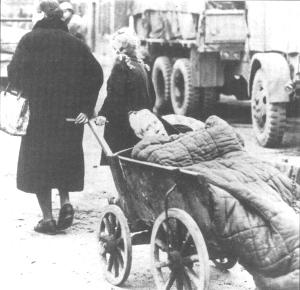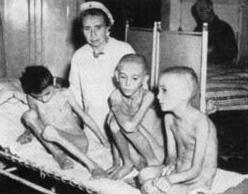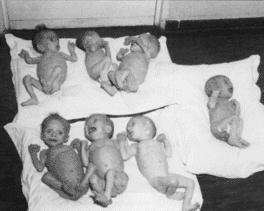Did the Allies Starve Millions of Germans?
James Bacque
Only Germany was left out.
It is well known in the West that the Allies hanged Nazis for crimes -- the murder of Jews, the brutal mass expulsions, the deadly forced-labour camps, the starvation of entire nations. What is not generally known is that these occupying armies carved off 25 percent of Germany's most fertile land and placed it under Russian and Polish control, forcibly expelling about 16 million people into what remained. It has also been forgotten -- or hidden -- that the Allies forbade emigration and kept millions of prisoners in forced-labour camps. International charitable aid to Germany was banned for another year, then restricted for more than a year. When it was permitted, it came too late for millions of people.
In a plan devised by U.S. secretary of the treasury Henry C. Morgenthau Jr., the Allies "pastoralized" Germany. They slashed production of oil, tractors, steel and other products that had been essential to the war effort. They cut fertilizer production by 82 percent. They under-valued German exports (which they controlled), depriving Germans of cash needed to buy food. And a large percentage of young male workers were kept in forced-labour camps for years. During the six months following the end of the war, Germany's industrial production fell by 75 percent.
The loss of so much fertile land and the drop in fertilizer supplies caused agricultural production to fall by 65 percent. Sixty million people began to starve in their huge prison.
 The mass expulsions from one part of Germany to another, approved at the Allied victory conference in Potsdam in July and August, 1945, were enforced "with the very maximum of brutality," wrote British writer and philanthropist Victor Gollancz in his book Our Threatened Values (1946). Canadian writer and TV producer Robert Allen, in an article titled Letter from Berlin, in Reading magazine (February, 1946), described the scene in a Berlin railway station as the refugees arrived in late 1945: "They were all exhausted and starved and miserable ... A child only half alive ... A woman in the most terrible picture of despair I've seen ... Even when you see it, it's impossible to believe ... God it was terrible." [Image: Expellees from the East; as many as sixteen million Germans were driven from their homes in history's greatest ethnic cleansing.]
The mass expulsions from one part of Germany to another, approved at the Allied victory conference in Potsdam in July and August, 1945, were enforced "with the very maximum of brutality," wrote British writer and philanthropist Victor Gollancz in his book Our Threatened Values (1946). Canadian writer and TV producer Robert Allen, in an article titled Letter from Berlin, in Reading magazine (February, 1946), described the scene in a Berlin railway station as the refugees arrived in late 1945: "They were all exhausted and starved and miserable ... A child only half alive ... A woman in the most terrible picture of despair I've seen ... Even when you see it, it's impossible to believe ... God it was terrible." [Image: Expellees from the East; as many as sixteen million Germans were driven from their homes in history's greatest ethnic cleansing.]
In the West, the plan to dismantle German industrial capacity began at the British headquarters of General Dwight Eisenhower in August, 1944. Meeting with Mr. Morgenthau, Gen. Eisenhower prescribed a treatment for Germany that would be "good and hard," giving as his reason that "the whole German population is a synthetic paranoid."
Mr. Morgenthau took a written version of their discussion to U.S. president Franklin Roosevelt and British prime minister Winston Churchill when the two met in Quebec City in September, 1944. British foreign secretary Anthony Eden, U.S. secretary of state Cordell Hull and U.S. secretary for war Henry L. Stimson all protested vigorously against the Morgenthau plan because a pastoralized Germany could not feed itself. Mr. Hull and Mr Stimson told Roosevelt that about 20 million Germans would die if the plan were implemented.
Most historians say the Morgenthau Plan was abandoned after the protests, but Mr. Morgenthau himself said it was implemented.
In the New York Post for Nov. 24, 1947, he wrote: "The Morgenthau Plan for Germany ... became part of the Potsdam Agreement, a solemn declaration of policy and undertaking for action ... signed by the United States of America, Great Britain and the Union of Soviet Socialist Republics."
I first happened on the outlines of this story while researching my 1989 book Other Losses, about the mass deaths of German prisoners of war in Allied camps. For 45 years, historians have never disputed a massive survey conducted over four years by the government of chancellor Konrad Adenauer, which stated that some 1.4 million German prisoners had died in captivity. What is still disputed by the two sides is how many died in each side's camps. Each has blamed the other for nearly all the deaths.
The fall of the Soviet empire in 1989 provided a spectacular test of the truth: If the KGB archives recorded how many Germans died in Soviet camps, the world would know how many died in the West.
In 1992, I went to the KGB archives in Moscow, where I was permitted to troll the long, gloomy aisles, free to read and photocopy anything I wanted. And there I found the reports from KGB colonel I. Bulanov and others showing that 450,600 Germans had died in Soviet camps. Given the figure of 1.4 million deaths, this meant that close to one million had died in Western camps.
In addition, the KGB records show that the Soviets had also imprisoned hundreds of thousands of civilians, of whom many thousands died.
This was the shadow of a greater tragedy, the fate of German civilians.
The recent declassification of the Robert Murphy Papers at the Hoover Institute in Stanford, California, and the Robert Patterson manuscript papers in Washington focused the picture. Mr. Murphy had been chief U.S. diplomatic adviser in Germany, and Mr. Patterson the secretary of war after 1945.
 Some of Mr. Murphy's papers show a catastrophic death rate in Germany, highlighted by a surprising comment by Mr. Murphy in discussing German demographics. He said in a State Department position paper in 1947 that the U.S. statistical projection of births, immigration and officially reported deaths showed that over the next three years the German population should be 71 million, but that "to be conservative and in view of the present high death rate in Germany, a figure of 69 million will be used." In other words, Mr. Murphy was basing high-level U.S. policy on the knowledge that the actual German death rate was approximately double the rate officially reported to Washington by the U.S. military governor. [Image: A British nurse in Berlin helps three German refugee children expelled from an orphange in Danzig, now Gdansk. The boy on the left, aged nine, weighs 40lbs and is too weak to stand. The boy in the center, aged twelve, weighs just 46lbs, and his eight-year old sister, right, weighs 37lbs.This picture was first published in Time magazine on 12 November 1945.]
Some of Mr. Murphy's papers show a catastrophic death rate in Germany, highlighted by a surprising comment by Mr. Murphy in discussing German demographics. He said in a State Department position paper in 1947 that the U.S. statistical projection of births, immigration and officially reported deaths showed that over the next three years the German population should be 71 million, but that "to be conservative and in view of the present high death rate in Germany, a figure of 69 million will be used." In other words, Mr. Murphy was basing high-level U.S. policy on the knowledge that the actual German death rate was approximately double the rate officially reported to Washington by the U.S. military governor. [Image: A British nurse in Berlin helps three German refugee children expelled from an orphange in Danzig, now Gdansk. The boy on the left, aged nine, weighs 40lbs and is too weak to stand. The boy in the center, aged twelve, weighs just 46lbs, and his eight-year old sister, right, weighs 37lbs.This picture was first published in Time magazine on 12 November 1945.]
In the National Archives in Ottawa, I found a document seized by Canadians in 1946, showing a death rate in the city of Brilon in north-central Germany almost triple the total reported for the Allies for their zones of Germany in 1945-46. The U.S. Army medical officer in Germany secretly reported that the actual death rate in the U.S. zone in May, 1946, was 21.4 per 1,000 per year, or 83 percent higher than the military governor was reporting to Washington.
These documents in Ottawa, Moscow, Washington and Stanford, recently revealed or long neglected, show that the Allies not only destroyed most German industry, they also reduced German food production to the point that Germans received less food for long periods during several years than the starving Dutch had received under German occupation.
 "From 1945 to the middle of 1948, one saw the probable collapse, disintegration and destruction of a whole nation." These are not the words of a revisionist historian of the 1990s, but the sober judgment of a U.S. Navy medical officer on the scene. Captain Albert Behnke compared German and Dutch starvation: For months in parts of Germany, the ration set by the occupying Allies was 400 calories per day; in much of Germany it was often around 1,000, and officially for more than two years it was never more than 1,550. The Dutch always got more than 1,394. [Image: Seven starving babies in the Catholic children's hospital in Berlin, October 1947. The infant on the right is near death.]
"From 1945 to the middle of 1948, one saw the probable collapse, disintegration and destruction of a whole nation." These are not the words of a revisionist historian of the 1990s, but the sober judgment of a U.S. Navy medical officer on the scene. Captain Albert Behnke compared German and Dutch starvation: For months in parts of Germany, the ration set by the occupying Allies was 400 calories per day; in much of Germany it was often around 1,000, and officially for more than two years it was never more than 1,550. The Dutch always got more than 1,394. [Image: Seven starving babies in the Catholic children's hospital in Berlin, October 1947. The infant on the right is near death.]
And for his part in starving people in the Netherlands, Nazi commander Arthur Seyss-Inquart was hanged by the Allies.
A comparison of the German censuses of 1946 and 1950 shows the effect of the food shortages. The 1950 census showed 5.7 million people fewer than there should have been according to the number of people recorded in the 1946 census, minus officially reported deaths, plus births and "immigrants" (people expelled from the east and returning prisoners) in the period from 1946 to 1950.
Mr. Murphy had, indeed, been conservative, partly because he underestimated the number of prisoners due to return to Germany from Russia. The total tally of unacknowledged deaths among prisoners, refugees and non-expelled civilians comes to around nine million people between 1945 and 1950, far more than the number who died during the war itself. All of these deaths were surplus to those actually reported.
While Germans starved, the Canadian-U.S. relief program swung into action in other parts of the world. Former U.S. president Herbert Hoover, then chief food adviser to president Harry Truman, flew around the world assessing need and supply. He found big regions of food poverty, as there has always been and still are, but not insurmountable world food shortage. In fact, world food production in 1945, according to the U.S. government statistics, was 90 per cent of the average of the years from 1936 to 1938. By the end of 1946, it was virtually normal.
Mr. Hoover begged, borrowed and bought enough food from the few other surplus countries -- Australia and Argentina -- to feed nearly all the world's starving. He congratulated Canadians warmly for their co-operation in a CBC speech in Ottawa in 1946: "To Canada flows the gratitude of hundreds of millions of human beings who have been saved from starvation through the efforts of this great Commonwealth."
As Mr. Hoover pronounced victory over the greatest famine threat in world history, Germans were entering their worst year ever. In early 1946, reports of conditions in Germany led U.S. senators, among them Kenneth Wherry and William Langer, to protest against "this addlepated... brutal and vicious Morgenthau Plan."
Belatedly, Mr. Truman asked Mr. Hoover to intervene. Mr. Hoover spoke to all North Americans: "Millions of mothers are today watching their children wilt before their eyes." Infant mortality rates in some German cities were 20 per cent per year, catastrophically higher than the average in Germany before the war or in contemporary Europe.
Cases of tuberculosis among children in Kiel, in the British zone, increased by 70 per cent over the prewar period.
Mr. Hoover called for mercy to Germany.
"I can only appeal to your pity and your mercy...Will you not take to your table an invisible guest?"
Canadians and Americans set the table for the invisible guest.
According to prime minister Mackenzie King's chief foreign-affairs adviser, Norman Robertson, Canada was the only country that had kept its food commitments to help the starving. Only in Canada did rationing and price controls continue long after the war so that others could be fed.
This unique campaign saved 800 million lives, according to Mr. Hoover.
Some older Germans treasure the memory of the "Hoover Speise" (meal) that warmed their bodies at school in 1947. Many millions -- including hundreds of thousands of Canadians born in Germany -- also remember their homes in parts of Germany now under Polish or Russian rule. None dreams of reparations; all yearn for us to know their story.
Bacque's Crimes and Mercies can be purchased from The Institute for Historical Review, PO Box 2739, Newport Beach, CA 92659. $18.95 postpaid (CA sales tax $1.31).
No comments:
Post a Comment